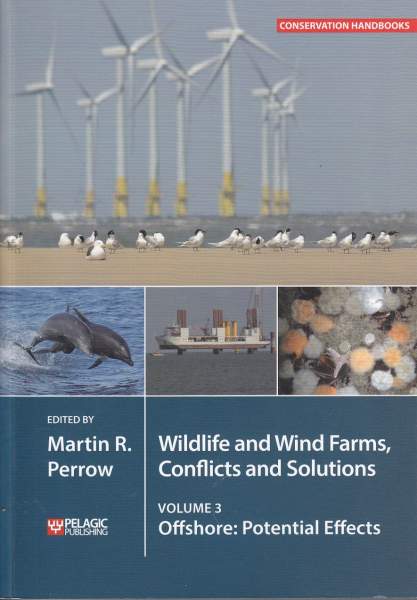
Publisher: Pelagic Publishing, Exeter
Publication Year: 2019
Binding: Softback
Page Count: 300
ISBN Number: 9781784271275
Price: £ 45.00
Wildlife and Wind Farms: Conflicts and solutions, Volume 3 - Offshore: Potential Effects
As a relative newcomer to the offshore wind industry, I found this book incredibly useful for explaining the underlying principles of the major elements of the industry, and for getting a good overview of how the sector works. Excellent diagrams, tables, figures and case studies are used throughout to support the clear explanations of, sometimes complicated, processes. The chapter layout flows well, so that each new chapter builds on knowledge from previous ones, such that there is an accumulation of understanding as you move through the book, with little room left for confusion.
Having not read the previous two volumes in this series (Onshore: Potential Effect and Onshore: Monitoring and Mitigation), I found the preface very useful for gaining an overview of the project history and aims, and contextualizing it within the series.
Chapter 1 gives an overview of the current global offshore wind farm (OWF) status, with a European focus, and provides a technical overview of what OWFs are, and how the planning, consenting, construction and post-construction processes work, including the legislation and regulation involved. This provides good technical background knowledge, so it’s best to read this chapter thoroughly if you’re unfamiliar with OWF processes in Europe, Asia and the USA, as it’ll provide the context that allows you to dip in and out of the subsequent topic specific chapters. The content is explained using a range of text, tables, figures and case studies to suit all learning styles.
Chapters 2 and 3 focus on the effect OWFs can have on the physical environment, while chapters 4 – 9 focus on the effects to different taxonomic groups. Together these give a holistic overview of the effects that may be caused by OWFs, but each chapter can be read in isolation depending on one’s specialism and specific areas of interest/concern.
Chapter 2 covers physical and chemical effects. The effects of turbines on hydrodynamics and coastal processes are explained, as well as what chemicals may be introduced to the environment, during the whole lifespan of an OWF. Case studies are provided to illustrate effects, and a variety of figures are presented to provide visual explanations. Chapter 3 covers effects to atmosphere and ocean dynamics, such as wind-wake and upwellings, in a more theoretical framework. There are a lack of empirical data to test these well-founded theories, but the potential positive and negative effects of them are discussed, and suggestions made to further this area of research. Again useful figures and tables are presented to help explain modelling processes, making them accessible to people with no background in this area.
Chapters 4 – 9 cover the likely effects to be experienced by different ecosystem and taxonomic groups, starting with benthic communities (Chapter 4), fish (Chapter 5) and marine mammals (Chapter 6), and moving onto birds and bats (Chapter 7). Specific effects to seabirds are covered in depth in Chapters 8 and 9. All of these chapters give a good grounding in the current state of international knowledge (published and grey literature) surrounding these groups and OWFs, and present case studies to support the major areas covered.
I would highly recommend this book to any novices looking to gain an in depth overview of OWFs and the challenges faced within the offshore wind energy sector. It’s also good for those specialists looking to gain a more holistic view of the ecological and environmental effects that OWFs may have, thus broadening their ability to work constructively with other specialists in the sector to minimise environmental impacts as a whole.
Book reviewed by Ros Green
buy this book





Share this page